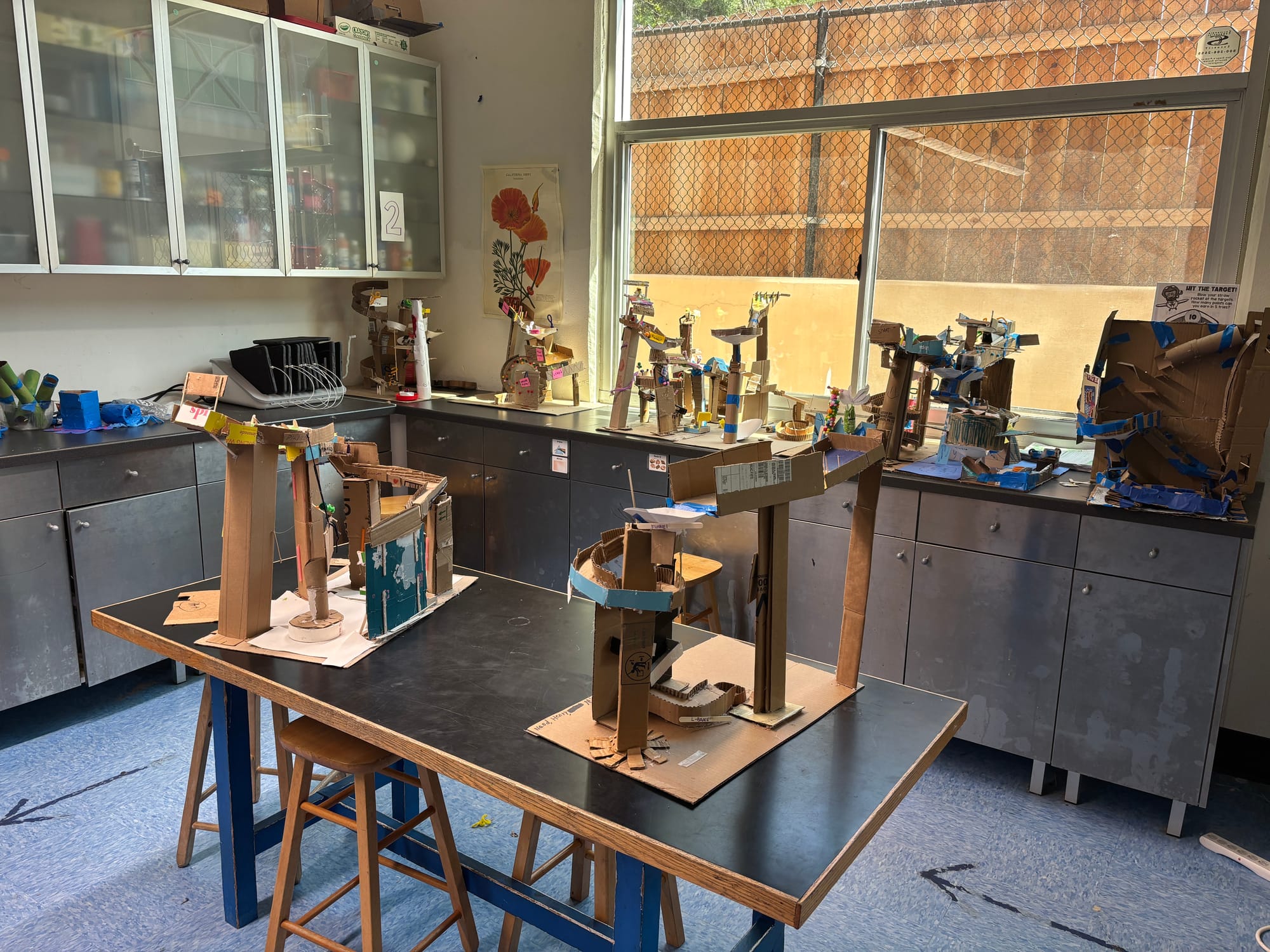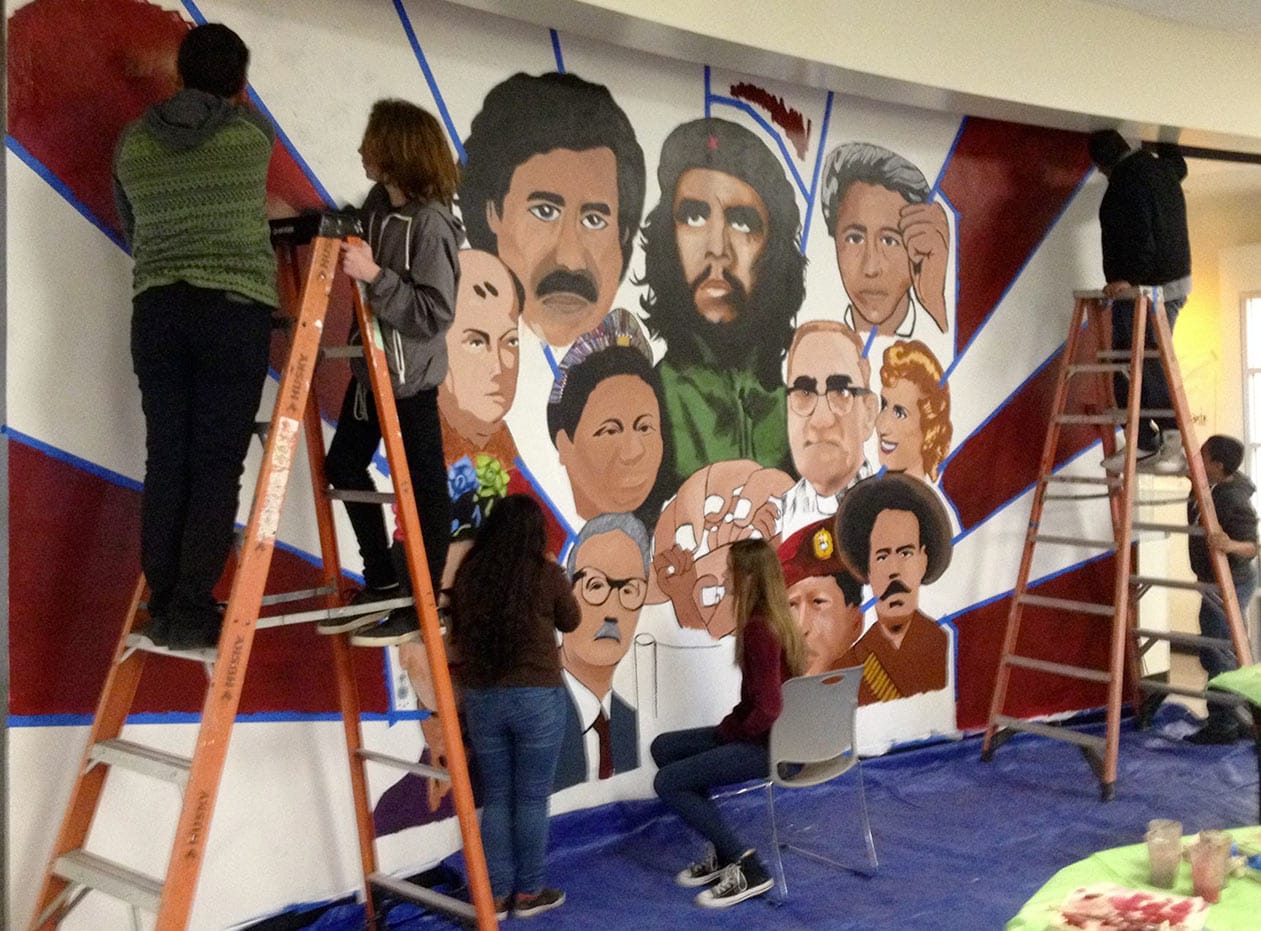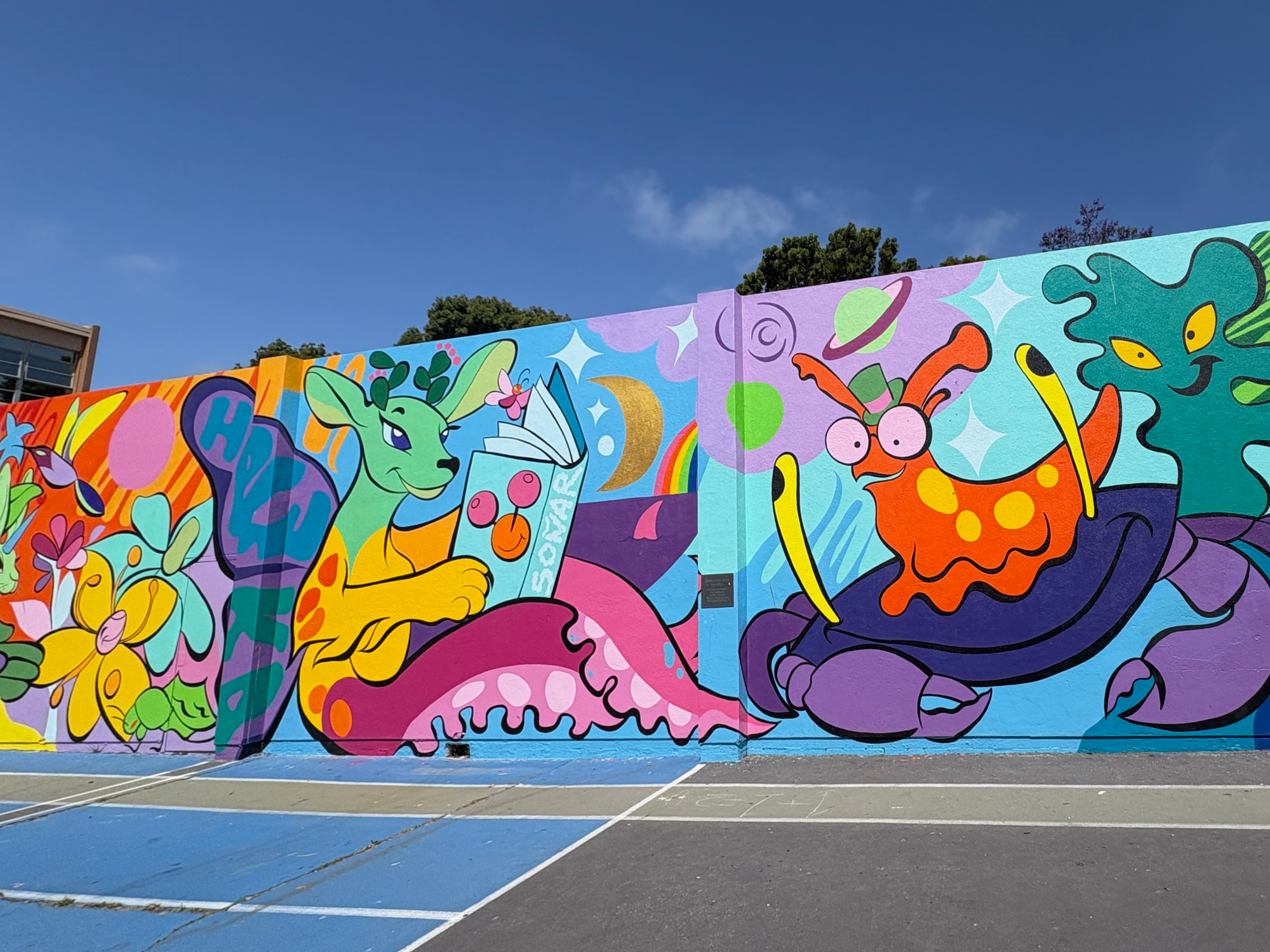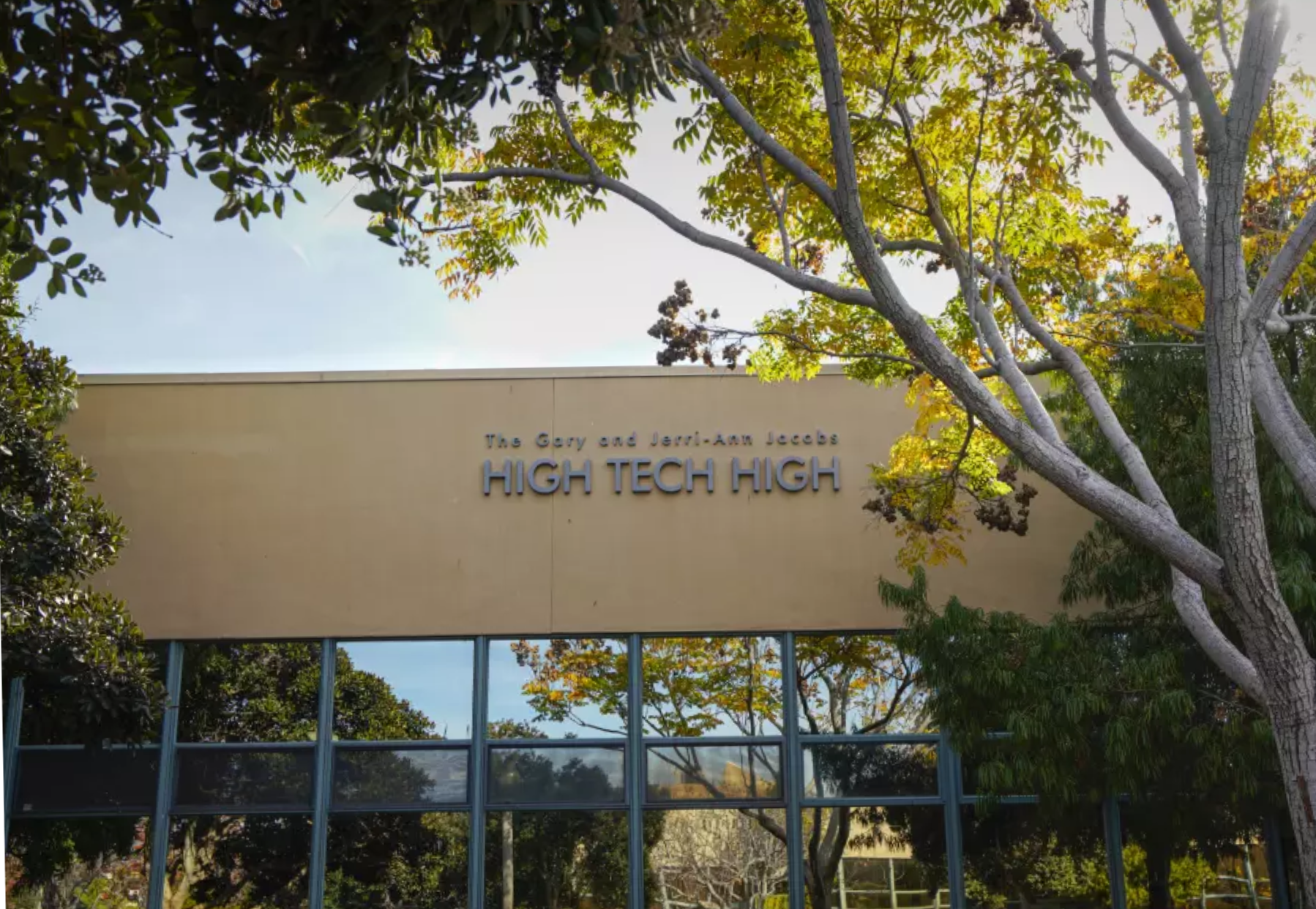At High Tech High, there’s no need to raise your hand to speak. There’s no podium. No bell. And no one calls the teachers Mr. or Ms. anything.
In fact, students just use their teachers’ first names. And somehow, maybe because of that, they speak to them not just with ease, but with genuine trust.
When we visited the High Tech High campuses in San Diego (including the elementary, middle, and high schools) we were struck not just by what students were learning, but by how they talked about the people guiding them. Over and over, students described their teachers as people they liked, respected, and felt comfortable around.
“You can tell they really care about us”, one student said simply.
Teachers didn’t seem to be managing behavior so much as joining students in the work. We saw them laughing side-by-side, talking casually in the hallways, brainstorming at eye level around whiteboards. If you weren’t told who the teacher was, you might not have guessed right away.
There’s a lightness to the dynamic here—but don’t confuse it with a lack of rigor. The relationships are relaxed because they’re rooted in mutual respect, not hierarchy. Students know that teachers are there for them. And that gives them the confidence to ask questions, take creative risks, and explore the unknown without fear of being judged or controlled.
From Authority to Partnership
High Tech High rejects the sage on the stage model that still dominates many classrooms. Instead of positioning teachers as the sole source of knowledge, it reframes them as facilitators, collaborators, and designers of experiences.
This shift isn’t just cosmetic—it rewires the emotional core of the learning environment.
Compare this to the conventional classroom model many of us grew up in. Teachers stood at the front. Students sat in rows. The job of the teacher was to maintain order, deliver content, and enforce deadlines. The student’s job was to comply.
That system might produce discipline, but it doesn’t always foster curiosity, trust, or personal growth. And it rarely builds the kind of lifelong love of learning that stays with students long after graduation.
At High Tech High, students see their teachers as people they could talk to, relate to, and learn alongside. The classroom felt less like a lecture hall and more like a shared studio.

We saw echoes of this same dynamic at Imagine High in British Columbia. There, students spoke about teachers as collaborators in their creative projects—people who gave feedback, shared in the ups and downs, and helped push their work to new levels.
Advisory: A Circle of Trust
At High Tech High, the advisory program is a cornerstone of the school’s relational culture. From middle school through high school, each student is part of a small, consistent group led by a dedicated advisor. These groups meet regularly to foster connection, reflection, and mutual support.
In middle school, students join an advisory group that stays together for all three years. The same structure continues in high school, with students forming new advisory groups that persist throughout their high school journey. This continuity allows deep relationships to form, both among peers and between students and their advisor.
Advisory sessions often begin with simple check-ins or games—sometimes silly, sometimes soulful. It’s where students learn to share space, take turns, speak truthfully, and really listen. Over time, these gatherings become a trusted environment where students can discuss challenges, celebrate successes, and develop essential social-emotional skills.
The role of the advisor is pivotal. Acting as a mentor and facilitator, the advisor guides discussions, supports individual student growth, and helps navigate academic or personal challenges. This consistent presence ensures that every student is known, heard, and valued within the school community.
“Phil was a very bright student who was in and out of school—he’d be around for a few days, then gone for a week. His parents didn’t even know he was missing; he’d come to school, then boot around the corner. Eventually, he came back and just stayed. He was present, doing great stuff. In our advising group, a kid said, ‘Man, you’ve really been around for a while.’ Phil said, ‘Yeah, well, I’ve changed. I had a really bad trip on drugs, and I decided I wasn’t going to do it anymore and I came back and here I am.’ When asked what the hardest part was, he said, ‘The toughest thing was that I changed, and it was three months before anybody noticed. My friends, my teachers—they all thought I was the old Phil. I was the new Phil, and nobody noticed.’ That hit me hard. I hadn’t noticed either. My message to teachers is: aspire to be the one who notices. And the only reason that conversation even happened was because we had a place for it—advisory. That’s why it matters.”
- The Wisdom of Rob Riordan (co-founder of High Tech High)
This advisory model reflects High Tech High’s commitment to personalization and community. By structuring these small, supportive groups, the school ensures that relationships are at the heart of the educational experience.
Learning from the Past
While High Tech High feels modern in many ways, there’s something ancient in its approach to the teacher’s role. In classical traditions from Greece to India, the teacher was less an enforcer and more a guide or companion—someone who walked beside you, posed questions, challenged your thinking, and gave feedback with care.
In Socratic dialogue, the teacher’s power lay in asking questions that helped students uncover meaning for themselves. In many Buddhist and yogic traditions, the student sought the teacher not for control, but for presence and insight.
High Tech High may not be invoking those traditions directly, but the spirit of them is alive in the way students and teachers engage with each other: curiously, respectfully, and with a sense of shared purpose.


How often do students get to paint something on the walls of your school?
Designing for Relationship
High Tech High’s teachers are learning guides, not subject matter experts. This distinction is deeply cultural and is reflected in the structures of the school. For instance, High Tech High:
- Organizes teams of teachers and students to stay together across multiple years
- Encourages co-teaching models to reduce isolation
- Supports teachers in designing interdisciplinary projects that they themselves find exciting
- Prioritizes advisory structures to deepen connection and mentorship
As a result, teachers don’t just teach content—they teach students. And students, in turn, feel safe enough to be seen.
During our visit, we met Jade, a school director who shared a beautiful example of how this philosophy extends beyond the classroom. She described a moment when it became clear that teachers across the school were using wildly inconsistent assessment systems. Instead of issuing a directive or enforcing a top-down solution, she simply showed the full team what was happening and invited them to respond. “This is confusing for students,” she said. “How do you want to handle it?”
That moment—like so many we saw—revealed a relational mindset not just between teachers and students, but between leaders and staff. Respect and trust weren’t just classroom strategies; they were part of the entire culture.
High Tech High also handles discipline and conflict in ways that preserve mutual respect. Restorative practices are central to their approach: rather than issuing punishments, teachers facilitate conversations that allow students to reflect, repair, and reconnect. Classroom norms are co-created, and regular advisory sessions give students space to process challenges together. The result is a school culture that values accountability and compassion equally.
Beyond the Name
It’s worth pausing to say: the name High Tech High is a bit of a misnomer. Despite what the name suggests, the school isn’t focused on technology. That’s not to say there aren’t tools or digital projects here, but technology isn’t the point. Relationships are. Trust is. Joyful learning is.

The name may be misleading, but the mission was always clear. Gary and Jerri-Ann Jacobs, longtime education advocates and key founders of the school, helped dream-up and launch High Tech High in the late 90's with a vision that went far beyond gadgets and screens. They believed in building a place where students would be seen, where learning would feel alive, and where teachers and students could do real work that matters—together. Their generosity and leadership continue to shape the school’s culture today.
This makes the school’s impact all the more striking. The thing people often assume will be its defining feature (technology) is actually a minor detail. The heart of the work lies elsewhere. You can really get a sense of this in one of our favourite documentaries, Most Likely to Succeed, which highlights High Tech High and introducted us to the school a decade ago.
Coming back Home
In British Columbia, we often talk about student-centered learning. But the underlying teacher-student dynamic in many schools is still defined by hierarchy, formality, and control. Even when pedagogical approaches shift, the emotional tone of the classroom can remain the same.
What would it look like to build relational trust as a design principle, not just a byproduct?
What if professional development focused less on classroom management and more on relationship-building?
What if teachers were trained, and trusted, to co-create learning experiences with students?
While High Tech High may seem unique, some Canadian schools are already following similar paths. Here in BC, students at Imagine High told us they look to their teachers as friends, showing us that reimagining teacher-student relationships is already happening—and it’s working.
We’re on the hunt for more Canadian classrooms with a similar culture. If that sounds like you, please get in touch!



